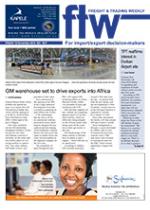The Philippines is expected
to become a Top Three
perishable market for
Maersk Line, according to
senior director for reefer
management, Thomas
Eskesen.
Much of the cargo in
and out of the country
(in the latter case, mainly
bananas) is shipped
breakbulk though many
of the old breakbulk
vessels are being scrapped,
paving the way for reefer
containers.
Rounding out the line’s
Top Three from a fresh
fruit perspective are Brazil
and West coast South
America, particularly
Chile/Ecuador.
Not to suggest South
Africa is an unimportant
reefer market. Perishable
Products Export Control
Board (PPECB) statistics
suggest containers
represented 79% of South
Africa’s export market in
2009/10, of which Maersk
and sister line Safmarine
handled nearly half.
The biggest limiting
factor in terms of viable
growth in South Africa
remains the country’s poor
port productivity.
“We have historically
seen very nice expansion
in South Africa and it has
clear potential to grow in
importance, as a share of
our global market.
“Not only does the
country have easy access
to Europe and the Far
East but one could
speculate it will benefit
from developing markets
in China, India and the
Middle East so South
Africa is really in a sweet
spot.”
Eskesen acknowledges
large parts of Africa are
growing much faster in
reefer terms and are likely
to outpace South Africa in
the longer term.
“We are seeing explosive
growth in countries like
Egypt and Morocco with
their huge investments
in grapes and citrus.
Cameroon is growing
banana and pineapple
exports and there’s huge
growth in Nigeria, which
imports about one million
tons of mainly pelagic fish
a year, mainly from the
Mauritania area but also
from Norway, Peru and
China.
“Business is also
huge for us in Angola
with reefer chicken
imports from Brazil and
we also expect reefer
exports to begin, which
is really the sustainable
way for Africa’s largely
agricultural products to
go.”
What is a stark reality is
that the reefer sector, while
more complex, has become
all the more flexible and
in some instances, cheaper
than airfreight.
It must be said, though,
technology does not come
cheap. Development costs
for the Aqualife lobster
reefer container are
estimated at around
US$100 000 apiece.
Poor port productivity stunts SA’s reefer potential
19 Nov 2010 - by Ray Smuts
0 Comments
FTW - 19 Nov 10

19 Nov 2010
19 Nov 2010
19 Nov 2010
19 Nov 2010
19 Nov 2010
19 Nov 2010
19 Nov 2010
Border Beat
16 Apr 2025
